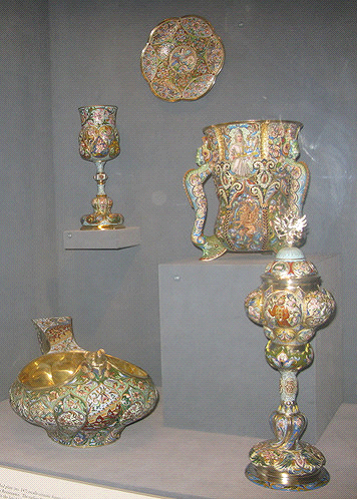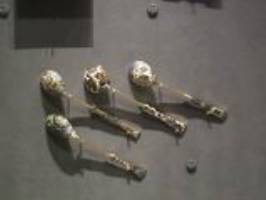Музеи и выставки

The Virginia Museum of Fine Arts' world-renowned collection of Russian imperial Easter eggs by Peter Carl Faberge and other Russian decorative arts is now on view.
The museum's collection of Faberge objects is one of the largest
The museum's collection of Faberge objects is one of the largest
Здание этого музея было открыто в 1936. Здание в стиле английского ренессанса было спланировано фирмой Пиблс энд Фёргусон Аркитектс оф Норфолк. Этот музей является одним из музеев Амерканского Юга, финансируемого только на средства штата.
В музее есть небольшая коллекция американской живописи и современной скульптуры. Но основу галлереи музея является самая богатая коллекция изделий Фаберже зa пределами России
В музее есть небольшая коллекция американской живописи и современной скульптуры. Но основу галлереи музея является самая богатая коллекция изделий Фаберже зa пределами России
Также в музее представлены работы фирмы известного русского эмальера немецкого происхождения Фёдора Рюкерта, часто сотрудничавшего с московским офисом Фаберже и часто цитирующего работы Васнецова и Билибина
Работы Фёдора Рюкерта входили в коллекцию русской эмали ньюйоркских любителей европейского искусства супружеской пары Риты и Джерома Гансов. После смерти мужa 1996 Рита Ганс безвозмездно передала свою коллекцию музею
Работы Рюккерта в собрании Музея
Discover the story behind the renowned House of Fabergé, the luxury brand created by preeminent artist and jeweler Peter Carl Fabergé (1846–1920).
"Fabergé: Designing Luxury” brings to metro Detroit more than 200 precious objects from the Virginia Museum of Fine Arts, the home of the largest collection of Fabergé in the United States. The show traces Peter Carl Fabergé’s rise to fame, highlighting his business savvy, artistic innovations, and privileged relationship with the Russian aristocracy. Despite the firm’s abrupt end in 1918, the legacy and name of Fabergé continues to hold a place in the popular culture.
Visitors will have the rare opportunity to glimpse imperial Russian treasures made by the House of Fabergé, including jewel-encrusted parasol and cane handles, an array of enameled frames, animals carved from semi-precious stones, and miniature egg pendants. The exhibition features four exquisite imperial Easter eggs. These one-of-a-kind objects, which took at least a year to create, have become synonymous with the name Fabergé. One stunning example is the Imperial Tsesarevich Egg, made of lapis lazuli, diamonds, and gold and opens to reveal a miniature portrait of young Alexei, the heir of Tsar Nicholas II. The objects on view will be exhibited with text, images, and activities meant to help visitors imagine the ways in which such luxury items would have been manufactured in a workshop, displayed in a storefront, and used to adorn the interior of the imperial palace.
Caption
Feodor Rückert, Loving Cup, 1896-1908, silver gilt, enamel, garnets, Siberian hardstones, Virginia Museum of Fine Arts, Richmond. Jerome and Rita Gans Collection of Russian Enamel. Photo: Travis Fullerton. © Virginia Museum of Fine Arts
"Fabergé: Designing Luxury” brings to metro Detroit more than 200 precious objects from the Virginia Museum of Fine Arts, the home of the largest collection of Fabergé in the United States. The show traces Peter Carl Fabergé’s rise to fame, highlighting his business savvy, artistic innovations, and privileged relationship with the Russian aristocracy. Despite the firm’s abrupt end in 1918, the legacy and name of Fabergé continues to hold a place in the popular culture.
Visitors will have the rare opportunity to glimpse imperial Russian treasures made by the House of Fabergé, including jewel-encrusted parasol and cane handles, an array of enameled frames, animals carved from semi-precious stones, and miniature egg pendants. The exhibition features four exquisite imperial Easter eggs. These one-of-a-kind objects, which took at least a year to create, have become synonymous with the name Fabergé. One stunning example is the Imperial Tsesarevich Egg, made of lapis lazuli, diamonds, and gold and opens to reveal a miniature portrait of young Alexei, the heir of Tsar Nicholas II. The objects on view will be exhibited with text, images, and activities meant to help visitors imagine the ways in which such luxury items would have been manufactured in a workshop, displayed in a storefront, and used to adorn the interior of the imperial palace.
Caption
Feodor Rückert, Loving Cup, 1896-1908, silver gilt, enamel, garnets, Siberian hardstones, Virginia Museum of Fine Arts, Richmond. Jerome and Rita Gans Collection of Russian Enamel. Photo: Travis Fullerton. © Virginia Museum of Fine Arts


